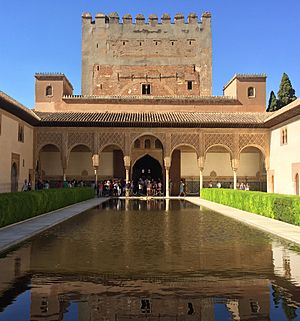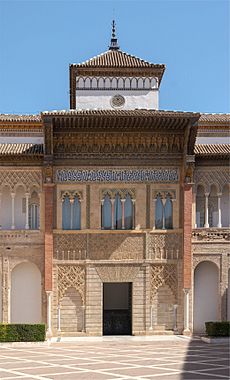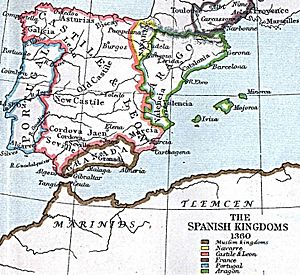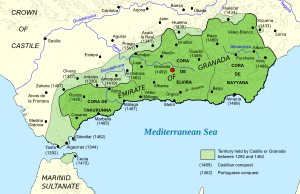Muhammad VI of Granada facts for kids
Quick facts for kids Muhammad VI |
|||||
|---|---|---|---|---|---|
| Sultan of Granada | |||||
| Reign | June/July 1360 – April 1362 | ||||
| Predecessor | Ismail II | ||||
| Successor | Muhammad V | ||||
| Born | 1333 Granada (presumed) |
||||
| Died | 25 April 1362 Tablada, near Seville |
||||
|
|||||
| Dynasty | Nasrid | ||||
| Father | Ismail ibn Abdullah | ||||
| Religion | Islam | ||||
Muhammad VI (Arabic: أبو عبد الله محمد بن إسماعيل, 1332–27 April 1362) was the tenth Sultan of the Emirate of Granada. He was also known as el Bermejo ("The Red One") by the Castilians. This nickname likely referred to his reddish hair and beard. His official titles were al-Ghālib bi 'llāh (Arabic: الغالب بالله, lit. 'Victor by the Grace of God') and al-Mutawakkil ʿalā 'llāh (Arabic: المتوكل على الله, lit. 'He who relies on God').
Muhammad VI was a member of the Nasrid dynasty, the ruling family of Granada. He ruled for a short time, from June or July 1360 to April 1362. He was a cousin and brother-in-law to both Muhammad V and Ismail II. In 1359, he helped overthrow Muhammad V and put Ismail II on the throne.
Muhammad VI gained more and more power during Ismail's rule. In 1360, he had Ismail killed and became Sultan himself. Some historical writings describe him as a harsh ruler with rough manners. In October 1360, he joined forces with Peter IV of Aragon against Peter I of Castile in a war. However, Aragon later made peace, leaving Muhammad VI to fight Castile alone.
Castile then allied with Muhammad V, who had returned from exile. Muhammad VI had some early wins against this new alliance. But by February 1362, Peter I and Muhammad V started winning many battles. Muhammad VI fled Granada on April 13, allowing Muhammad V to become Sultan again. Muhammad VI then surrendered to Peter I in Seville. However, Peter I was angry about Muhammad VI's past alliance with Aragon. He personally killed Muhammad VI on April 27, 1362.
Contents
Granada's Place in History
The Emirate of Granada was the last Muslim state in Spain. It was founded in the 1230s by Muhammad I. Granada managed to stay independent for a long time. It was located between two powerful neighbors. To the north was the Christian Crown of Castile. To the south was the Muslim Marinid Sultanate in Morocco.
Granada would sometimes form alliances or go to war with these powers. It also encouraged them to fight each other. This helped Granada avoid being controlled by either one. Sometimes, the Sultans of Granada would promise loyalty and pay money (called tribute) to the kings of Castile. This tribute was an important source of money for Castile. Castile saw Granada as a kingdom under its control. However, Muslim writings never described it that way.
Muhammad VI's Family
| Family tree of Muhammad VI and his predecessors | |||||||||||||||||||||||||||||||||||||||||||||||||||||||||||||||||||||||||||||||||||||||||||||||||||||||||||||||||||||||||||||||||||||||||||||||||||||||||||||||||||||||||||||||||||||||||||||||||||||||||||||||||||||||||||||||||||||||||||||||||||||||||||||||||||||
|---|---|---|---|---|---|---|---|---|---|---|---|---|---|---|---|---|---|---|---|---|---|---|---|---|---|---|---|---|---|---|---|---|---|---|---|---|---|---|---|---|---|---|---|---|---|---|---|---|---|---|---|---|---|---|---|---|---|---|---|---|---|---|---|---|---|---|---|---|---|---|---|---|---|---|---|---|---|---|---|---|---|---|---|---|---|---|---|---|---|---|---|---|---|---|---|---|---|---|---|---|---|---|---|---|---|---|---|---|---|---|---|---|---|---|---|---|---|---|---|---|---|---|---|---|---|---|---|---|---|---|---|---|---|---|---|---|---|---|---|---|---|---|---|---|---|---|---|---|---|---|---|---|---|---|---|---|---|---|---|---|---|---|---|---|---|---|---|---|---|---|---|---|---|---|---|---|---|---|---|---|---|---|---|---|---|---|---|---|---|---|---|---|---|---|---|---|---|---|---|---|---|---|---|---|---|---|---|---|---|---|---|---|---|---|---|---|---|---|---|---|---|---|---|---|---|---|---|---|---|---|---|---|---|---|---|---|---|---|---|---|---|---|---|---|---|---|---|---|---|---|---|---|---|---|---|---|---|---|---|---|---|
Note: Partial family tree. Previous sultans are indicated with yellow. |
|||||||||||||||||||||||||||||||||||||||||||||||||||||||||||||||||||||||||||||||||||||||||||||||||||||||||||||||||||||||||||||||||||||||||||||||||||||||||||||||||||||||||||||||||||||||||||||||||||||||||||||||||||||||||||||||||||||||||||||||||||||||||||||||||||||
Muhammad ibn Ismail was born on March 18, 1333, probably in Granada. He was part of the ruling Nasrid dynasty. His grandfather was Abu Abdullah Muhammad ibn Faraj, who was the brother of Sultan Ismail I (ruled 1314–1325). This meant Muhammad VI was related to earlier sultans.
Muhammad VI was a second cousin to Muhammad V (ruled 1354–1359 and 1362–1391) and Ismail II (ruled 1359–1360). He also married a daughter of Yusuf I (ruled 1333–1354). Her name is not known, but she was Ismail II's full sister and Muhammad V's half-sister. They had at least one daughter. This daughter later married Muhammad ibn al-Mawl. Their children included Yusuf IV ibn al-Mawl, who would become sultan in 1432.
Before he became Sultan, Muhammad VI was called al-rais. This was a title for members of the royal family in Granada.
How Muhammad VI Gained Power

During Muhammad V's first time as Sultan, Muhammad VI was part of a secret plan. This plan aimed to remove Muhammad V and put Ismail II on the throne. Another important person in this plan was Maryam, Ismail's mother. She had a lot of money after Yusuf I died. Maryam often visited her daughter, who was married to Muhammad VI. During these visits, they planned the overthrow.
With Maryam's money, Muhammad VI led about 100 men in a surprise attack on August 23, 1359. This date was chosen because an astrologer said it would be lucky. Under the cover of night during the holy month of Ramadan, they climbed the walls of the Alhambra. The Alhambra was the fortified palace of the sultans. They found a part of the wall that had not been fixed and got inside. They quickly took over the guards.
They killed Muhammad V's chief minister, Abu Nu'aym Ridwan, in front of his family. They also destroyed his house and took his valuable belongings. Muhammad V was outside the Alhambra at the time. He tried to get the palace back but failed. He then fled to the city of Guadix. The plotters found Ismail, who was only about twenty years old, in his palace. They declared him the new Sultan.
A historian named Ibn al-Khatib, who worked for Muhammad V, said that Ismail was a weak ruler. Soon, Muhammad VI became very powerful. He was the real person in charge behind the Sultan. Muhammad V went into exile in North Africa. He had tried to get help from his ally, Peter I of Castile, but it didn't work.
Muhammad VI's power grew so much that Ismail started to oppose him. But before Ismail could do anything, Muhammad VI launched another violent attack. This led to Muhammad VI becoming Sultan himself. This happened either on June 24, 1360, or on the night of July 13. This was less than a year after Ismail became Sultan.
Muhammad VI's men surrounded Ismail. Ismail had locked himself in a tower. He was forced to give up and offered to live quietly away from power. But Muhammad VI took him, without shoes or a head covering, to a prison for criminals. There, Ismail was killed. Next, Muhammad VI found Ismail's young brother, Qays, and killed him too. Ismail's ministers were also executed. Historians believe Muhammad VI did this because he feared they might be used against him in the future. After these actions, Muhammad VI took the throne as Muhammad VI.
Muhammad VI's Rule
When Muhammad VI became Sultan, he took two special titles: al-Ghalib bi 'llah ("Victor by the Grace of God") and al-Mutawakkil ala 'llah ("He who relies on God"). This was unusual because he hadn't achieved anything major yet. Muslim historians described Muhammad VI as a rough man in his clothes and manners. They also said he was not good at speaking in public. He reportedly hunted with his dogs, appeared in public without a head covering and with his sleeves rolled up. He also had a twitch that made his head move from side to side.
Muhammad VI ruled like a tyrant. He punished anyone he thought supported Muhammad V. Because of his harsh rule and poor manners, many people at court left Granada. They fled to Morocco or to Christian Castile.
Muhammad VI made a deal with the Marinid Sultan of Morocco, Abu Salim Ibrahim. In this deal, Abu Salim would stop Muhammad V from returning to Spain. In return, Muhammad VI would arrest rebellious Moroccan princes who had found safety in Granada.
Muhammad VI changed Granada's foreign policy. His predecessors had allied with Castile. But Muhammad VI stopped paying the usual tribute to Castile. Instead, on October 9, 1360, he made an alliance with Castile's enemy, the Christian Crown of Aragon. This treaty lasted six years. It allowed Muslim subjects (called mudéjares) in Aragon to move freely. This was similar to a deal made in 1321. However, this part of the treaty soon became ineffective due to unofficial problems created by Peter IV. Letters between Muhammad VI and Peter IV of Aragon still exist today in Aragon's historical records.
Castile had defeated Aragon in a battle in 1360. But Peter I of Castile was worried about fighting on two fronts. So, he agreed to peace with Peter IV of Aragon in May 1361. Peter IV wrote to Muhammad VI, saying he made peace because the Pope asked him to. He also said he still wanted to be friends with the Sultan.
The Castilian king then turned his attention to Muhammad VI. He pressured Abu Salim, the Marinid Sultan, to let Muhammad V return to Granada. Peter I threatened to attack Marinid lands in Spain if Abu Salim refused. The Marinid Sultan agreed. Muhammad V sailed to Gibraltar in August 1361. A rival government was set up in Ronda, a Marinid outpost. Peter I provided money for this. When the Marinid and Castilian navies attacked Granada's coast, Muhammad VI asked Aragon for ships to fight the Marinids. He planned to deal with the Castilians himself.
Muhammad V and Peter I then launched an attack to remove Muhammad VI. In 1361, their troops defeated Muhammad VI's forces in Belillos. They moved towards the Vega of Granada. They seemed to win some small fights in Pinos Puente. But Muhammad VI's army did not switch sides, even with Muhammad V present. On January 15, 1362, Muhammad VI won a big victory against a Castilian attack near Guadix. He captured 2,000 prisoners, including important noblemen.
As a sign of goodwill, Muhammad VI returned some of the most important prisoners to Castile. These included Diego García de Padilla, a leader of the Order of Calatrava, and other knights. He also sent gifts. But this did not calm Peter I. Peter and Muhammad V combined their forces for an attack in February 1362. They captured Iznájar and Coria. However, Muhammad V became annoyed because Peter wanted to keep the captured lands for Castile. From March onwards, they led their campaigns separately.
Peter I captured many fortresses, including Cesna, Sagra (which Granada later took back), Benamejí, El Burgo, Ardales, Cañete, Turón, and Cuevas del Becerro. Meanwhile, Muhammad V captured Málaga, the second most important city after Granada. He also took many nearby castles. This gave him control of the entire western part of the emirate. These campaigns turned the war against Muhammad VI.
Muhammad VI's Downfall

Muhammad V's advances, along with unhappiness among the people about the civil war, made Muhammad VI realize he could no longer hold power. He fled Granada on April 13, 1362. He took most of the royal treasury with him, along with his followers. Muhammad V entered the Alhambra three days later and was recognized as Sultan again.
Muhammad VI then surprisingly surrendered to Peter I in Seville. Muhammad VI offered to rule Granada as Peter's loyal subject and serve him as a knight. If Peter chose to stay on Muhammad V's side, Muhammad VI asked to be sent into exile overseas. At first, Peter did not give a clear answer. He welcomed Muhammad VI and his followers. He allowed them to stay in the city's Jewish quarter near his palace as royal guests.
However, Peter I later acted against his guests. He arrested them after a feast he organized. He imprisoned all of Muhammad VI's followers in Seville's shipyard and took their riches.
Two days later, Muhammad VI was killed at Tablada, a castle near Seville, on April 25 or 27. Dressed in red, he was led on a donkey to a field. Then, he was tied to a stake. Peter I personally struck him with a spear. Peter said, "Take that for causing me to get a bad deal from the king of Aragon!" Muhammad VI replied in Arabic, "What a little deed of chivalry."
Peter I blamed Muhammad VI's alliance with Aragon for forcing him into a bad peace deal with Peter IV. In that deal, Peter I had to return several castles he had captured. A Castilian historian wrote that Muhammad VI's wealth was the main reason for the killing. Another historian said Peter also wanted to show his support for Muhammad V.
The execution angered many at the Castilian court. They thought it was a terrible act of betrayal. Peter I tried to justify it. He said it was punishment for Muhammad VI's betrayal of Muhammad V, for killing Ismail II, and for entering Seville without official permission. Without this permission, Peter argued there was no betrayal. Arabic sources, especially those that supported Muhammad V, agreed with Peter's reasons.
Along with Muhammad VI, 36 of his followers were killed. The rest, about 300 people, were imprisoned and later poisoned.
Sources
- "Naṣrids". The Encyclopaedia of Islam, New Edition, Volume VII: Mif–Naz. (1993). Leiden: E. J. Brill. 1020–1029.
- Vidal Castro, Francisco "Ismail II". Diccionario Biográfico electrónico. Real Academia de la Historia.
- Vidal Castro, Francisco "Muhammad VI". Diccionario Biográfico electrónico. Real Academia de la Historia.
|
Muhammad VI of Granada
Cadet branch of the Banu Khazraj
Born: 1332 Died: 1362 |
||
| Regnal titles | ||
|---|---|---|
| Preceded by Ismail II |
Sultan of Granada 1360–1362 |
Succeeded by Muhammad V |
See also
 In Spanish: Muhammed VI de Granada para niños
In Spanish: Muhammed VI de Granada para niños



